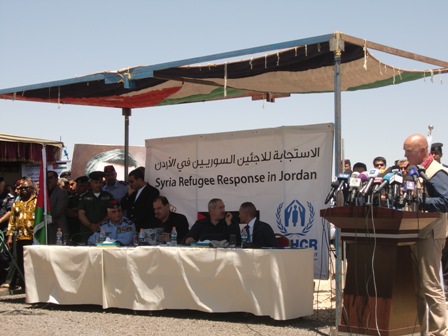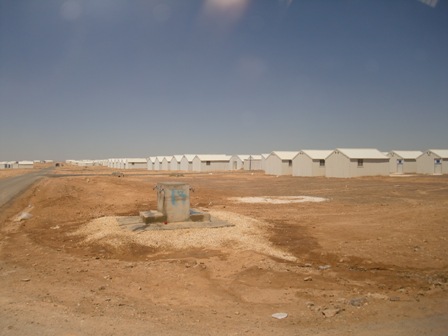8th May 2014
Syrian Refugees: Barrel Bombs or Basic Board?
Last week I went to the opening of the new Azraq camp for Syrian refugees in Jordan. There was no celebration: the new camp is unfortunately necessary to give shelter to the hundreds of refugees who daily flee their country’s brutal civil war.

Azraq will initially house 51,000 people and can increase to 130,000. The location is pretty bleak: an open, stony desert, exposed to dusty winds and the harsh heat of summer. The basic board and lodging the refugees will get is without doubt better than being targeted by barrel bombs. And no doubt the refugees will adapt it and make it their temporary home.
Jordan is now home to around 600,000 registered refugees and over 1 million Syrians, 1 Syrian for every 6 Jordanians. Over the last 3 years they have been warmly welcomed by the Jordanians who have shown magnificent hospitality and generosity in giving them shelter, food as well as free education and healthcare.
Many of the refugees are housed in Za’atri camp. With 100,000 people it is the second largest refugee camp in the world. When I first went there in July 2012 it was an empty, rocky open space with a few wind-blown tents. It is now a bustling community where Syrians have grouped themselves together in village communities, opened shops and restaurants and tried their best to make their families comfortable. The other main camp in Jordan was built by the UAE and is run by the UAE Red Crescent and houses around 5,000 Syrians.
The vast majority of the refugees in Jordan are not living in camps. Around 80% of the Syrians are living in Jordanian towns and villages where they are renting accommodation and, in many cases, trying to find work.

The places they have chosen to live are – almost inevitably – among the poorest parts of Jordan. Their arrival has pushed rents up and imposed a massive burden on municipal and state services. Despite this burden, the Jordanians have welcomed them as brothers.
The attitude of the refugees themselves has changed over time. The first arrivals were angry about the way the Assad regime had used helicopters, tanks and artillery to destroy their houses. They wanted rapid action to help them return. The hostility towards Assad as the cause of their plight remains, but they are increasingly resigned to the fact that it will take time before they can return to their homes.
You only have to talk to the refugees to understand the horrors they have seen. Many of them – and their children – have witnessed unspeakable atrocities and horrific cruelty. One man told me that he had seen his sister and her five children butchered by regime thugs, the Shabiha . Another described how, when her husband was killed, she walked for months from Homs to reach the safety of Jordan, hiding in abandoned buildings and every day fearing for her children’s lives.
Many of the children have lost at least 2 years of education. Refugee children can now go to schools in Za’atri camp and in Jordanian towns. But Syria risks losing a generation of children. This is not only an issue of missing schooling; it is about being traumatised by war, contaminated at a young age by violence and dislocated from the innocence of a normal childhood in a loving family. This is potentially the greatest tragedy of the conflict. For that reason the UK’s Development Secretary Justine Greening has launched a major ‘No Lost Generation’ initiative to help provide schooling for Syrian children. We also have to help the many Jordanian schools that have absorbed Syrian children.
The influx of Syrian refugees has dominated the work of the British Embassy in Amman in the last 3 years. The UK has devoted $1 billion to the humanitarian response to the Syria crisis. This represents the biggest UK response to any crisis ever. Our donations to Jordan amount to $250million. While much of this aid has gone to help the United Nations and international non-governmental organisations support Syrians, increasing amounts are going to support the Jordanian communities that host the refugees, including $20million to support the municipalities where most refugees live.
Where next? How long will this last? It is impossible to tell. But the key fact is that Jordan, along with other neighbouring countries like Lebanon and Turkey, has kept their border open to give sanctuary to refugees. It is the international community’s duty to support their generosity. The UK will continue to do so. So must other donors.
Dear Peter ,
there ´s in my opinion 1 small chapter in yr. report which is very remarkable for it “makes”you hoping but also causing a little bit of fear : yr. lines ´bout the current 600.000 “registered” refugees plus the additional 1 million Syrian ones. There´s hope that all these already (civil-war) traumatic or nightmarish wounded people will still be welcomed in Jordan and will further receiving hospitality and esp. healthcare. In Za ´atri Camp as well as in this described new Azraq Camp. On the other side there ´s also some kind of fear for I ´ve asked myself : “HOW LONG will these good facts still LASTING ?” For if there´s already “1 Syrian for 6 Jordanians” and new Azraq Camp alone is preparing to increase the number of civil war victims by 80.000 – when will the general mood , the general awarness amongst the Jordanian people itself be changing /turning into the opposite ? Well it ´s like you ´ve wrote : (today) it ´s impossible to say it. But it ´s possible to say that initiatives like the “No lost generation” by UK ´s Justine Greening and THE DUTY for further and stronger help/aid by the entire WORLD COMMUNITY will surely be ways by making this horrible current situation for all these desperate refugees a liitle bit more easier to take and stand.
Best wishes & take care of yourself , liebe Grüßle ond a sichere Zeit,
Ingo-Steven , Stuttgart